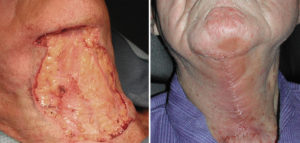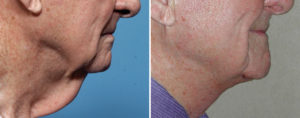Background: The turkey neck is an urban term used to describe a hanging of neck tissue that most commonly occurs as a result of aging. It may occur in younger patients but it would be due exclusively to the loose neck tissue that results from large amounts of weight loss. Regardless of the cause, the turkey neck hangs with a large midline sag as the the tissues along the sides of the face and neck fall towards the midline of the neck.
Men often appear for ‘turkey neck surgery’ because they often present at a much older age. The male trigger to undergo any type of invasive aesthetic facial surgery is usually much higher than that of women (traditionally) as they can endure facial aging changes for longer than most women. Large turkey necks are not uncommon in older men as they approach their 70s and 80s.
One of the challenges in the older male facelift patient is their medical appropriateness for surgery. They often have cardiovascular concerns and, at the least, many are being treated for hypertension. They are at higher risk for intraoperative bleeding and postoperative hematomas. And they have to have a good enough heart to tolerate a 3 to 4 hour facelift/necklift surgery. These concerns are in addition to the placement of incisions around the ears in men who have often inadequate hairlines and hair to hide them well.
Case Study: This 82 year-old male was bothered by his large turkey neck. He had ‘grown’ to the point where it was both embarrassing and problematic for shirt wear. Despite his age he was in good health with no cardiac history or exercise/walking in tolerance.


Highlights:
1) Very senior men with turkey necks can be challenging patients for traditional facelift surgery.
2) The direct necklift avoids most of the issue relating to doing a full facelift in older men.
3) The midline neck scar from a direct necklift does well in older male beard skin.
Dr. Barry Eppley
Indianapolis, Indiana


